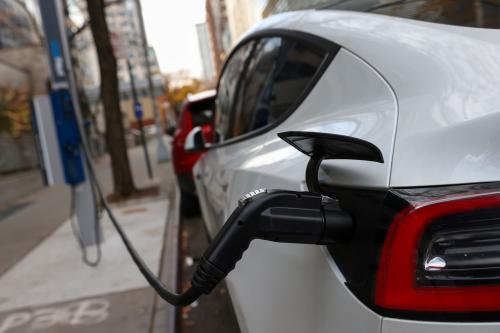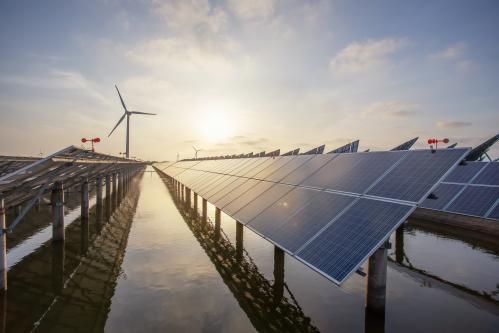A weakening dollar and recent increases in the price of oil, surpassing $100 per barrel for the first time, sent global financial markets tumbling and it appears likely that the price will continue to reach new highs in future months. Even worse, the oil price increases come at a time when the sub-prime mortgage crisis is dragging the economy into a possible recession, spreading the pain to American consumers beyond the gasoline pump – and all this in an election year Although the Bush administration still denies it, a situation of “stagflation,” similar to that in the 1970s when OPEC tripled the price of oil, may well be around the corner.
The high price of oil is hurting the American economy and is also doing harm to the Chinese economy. Last year China’s inflation rate, measured by the consumer price index (CPI), climbed to 4.8% after almost a decade of low financial risk. An “over-heated” economy, high investment, and a huge liquidity surge amid energy price spikes have dramatically raised the Chinese government’s concerns about inflation. Entering 2008, the CPI continued to soar to an alarming 7.1% in January (partially due to the major snowstorms in southern China), and made it more difficult to implement measures to ensure a future “soft landing” for the economy. Although Chinese consumers do not have to pay for oil price hikes as much as the American consumers do, due to huge government subsidies, the price spikes have certainly increased the Chinese government’s subsidy burden, drained its financial resources, and further worsened the price distortion in the Chinese economic system, a big potential danger that should not be underestimated. Looking down the road, if oil prices continue to climb and/or are manipulated by certain forces in the international market, further damage would certainly be done to the Chinese and American economies alike. Although people may have different views about what factors have driven the price up, including whether China’s oil purchases are responsible, the recent price hikes, once again, have highlighted the fact that China and the United States are equally affected by high oil prices and they share common interests in the pursuit of secure and affordable energy supplies.
The United States and China are the largest and second largest energy consumers in the world, respectively. Last year China was a net-importer of 159.28 million tons of crude oil, about 46% of its total consumption. The size of U.S. petroleum imports was 3.2 times larger than those of China, and Americans depend on foreign sources for over 60% of the energy they consume. With that in mind, Beijing and Washington have similar concerns in their energy policies and face the same set of challenges: high dependency on foreign sources of energy, rising energy-related environmental impacts, and energy conservation and efficiency, in addition to the effect on their economies of energy price spikes. Although China and the United States do not rely on each other for energy supplies, as the two largest oil consuming countries they are natural “energy bedfellows” in coping with similar challenges. They must cooperate, through joint or parallel action, to keep global energy supplies open, secure, and at an affordable price level. Neither country can hope to achieve much without the support of the other. Both would win if they choose to cooperate rather than confront each other in their pursuit of energy security.
The Sino-U.S economic relationship and the price of energy
Chinese economic growth and the U.S. economy have become highly interdependent with each other, with a bilateral trade volume of $386.7 billion in 2007. The U.S. economy has enjoyed an average 3.5% growth since 1992 with relatively low inflation. On the whole the United States has benefited greatly from a steady inflow of low-priced “Made in China” products, which has helped to keep the overall price of consumer goods low and consumer confidence high. On the other side of the linkage, Chinese economic growth has also benefited from its strong exports to the American market over the years. In assessing this interdependent economic relationship, it should not be forgotten that a sufficient and affordable energy supply and an abundant supply of cheap labor in China have been the key ingredients to this successful story. China’s economic miracle is based on labor-intensive, low-wage manufacturing and robust exports. Without a sufficient and affordable energy supply, this path of export-driven growth would encounter serious problems, and so would the Sino-U.S economic relationship, in its current form.
Of course, as the world’s largest and fourth largest economies, both the U.S. and China are capable of absorbing the economic impact of the recent oil price hikes. Indeed, to some extent, oil price hikes are not completely bad news for either. It would be conducive for both economies, particularly for the Chinese economy, to meeting government policy objectives of energy efficiency and energy reduction, environmental conservation, and reduction in dependence on foreign sources of energy. It is exactly in these policy areas that the two countries require dialogue rather than competition.
China-U.S. energy policy dialogues
The present Sino-American Energy Policy Dialogue (EPD) was established between China’s National Development and Reform Commission (NDRC) and the U.S. Department of Energy (DoE), in May 2004, to facilitate policy-level bilateral exchanges of views on energy security, economic issues, and energy technology options. Before the EPD was in place, the two governments also launched an Oil and Gas Industry Forum in 1998 to facilitate opportunities for government and industry leaders from both countries to have frank discussions about their respective needs in the oil and gas sector. At the international level, both countries have also been involved in multilateral forums, such as the Asia-Pacific Economic Cooperation (APEC), the Asia-Pacific Partnership on Clean Development and Climate (APP), and the International Energy Forum’s Joint Oil Data Initiative (JODI).
In December 2006, the EPD became part of the newly-launched China-U.S. Strategic Economic Dialogue (SED). In his inaugural speech to the SED, Treasury Secretary Henry Paulson stated that energy cooperation was one of the three pillars of the SED, together with “maintaining sustainable growth without large trade surpluses” and “continuing to open markets to trade, competition, and investment.” In his view, “[both countries] are committed to developing the use of cleaner, more abundant energy sources and we will talk about the best ways to do that.”[1]
As the two largest energy consumers in the world, it is useful for both governments to increase mutual understanding of each other’s energy policies, programs, and priorities, and the annual EPD has served that purpose since 2004. In the previous rounds, EPD discussion topics have included energy policy making, supply security, power sector reform, regulatory issues, energy efficiency, and the development of energy technology. In the dialogue, the Chinese side got familiarized with various U.S. policy initiatives under the Energy Policy Act of 2005 and what the U.S. government does to encourage the commercialization of advanced technology in the energy sector. For Americans, it was a good opportunity to learn from the Chinese energy officials about the rationales behind China’s policy of reducing energy intensity in the economy under China’s five-year planning cycle. Another EPD achievement is that China was encouraged to establish a strategic oil reserve as a hedge against supply disruptions: strategic oil reserve projects are currently under way at four different locations in China.
Nevertheless, although both countries feel very strongly about sustaining the world’s economic growth and ensuring access to reliable and affordable energy, the EPD and other government dialogue vehicles so far have achieved little beyond understanding each other’s policymaking and positions on various energy issues. The two governments really need to put in more effort toward producing concrete measures to advance Sino-U.S. energy cooperation, and to ensure energy security for both countries in practical ways.
Moving beyond energy “dialogues”
Future China-U.S. energy dialogues should proceed with more substantive discussion on advancing energy cooperation. There are several issues to which both governments should turn their attention. First, they should find ways to manage strategic anxieties on both sides. Both countries feel very strongly about sustaining global economic growth and ensuring energy security. This represents a great confluence for policy dialogues. But, at the same time, the two governments consider different factors in defining “energy security” and how to achieve it. Moreover, there are still many people in the U.S. who view China’s global oil search as an attempt to “lock up” energy resources around the world, and as part of an irresponsible mercantilist policy in Africa and Latin America. Similarly, there are not a small number of people in China who are concerned that the American intention is to “block” China’s way to acquire oil assets and to possibly threaten China’s oil transportation through maritime routes. These mutual suspicions and anxieties seem not to have disappeared despite the on-going EPD and strategic dialogues at various levels. China and the United States have similar oil interests and face common challenges. They should not view each other through a zero-sum lens. Political leaders in both countries should do more to reduce mutual suspicion and raise strategic comfort with each other.
Second, both sides need to take more substantial steps in facilitating cooperation in developing clean sources of energy and energy efficiency. Measures could include, but are not limited to: encouraging technological innovation, adopting highly efficient clean energy technology, promoting the sustainability of natural resources, and addressing climate change. Washington and Beijing should work together in a pragmatic manner in WTO multilateral negotiations on trade and environment, and engage in discussions on the reduction—or, as appropriate—elimination of tariff and non-tariff barriers to environmental goods and services.
Third, they should act in concert to stabilize petroleum prices in the international market. As OPEC flexes its muscles, oil consuming nations should act together, rather than compete among themselves. Samuel Berger, former National Security Advisor in the Clinton Administration, proposed that the U.S. should coordinate with fellow oil-consuming nations, including India, Japan, and particularly China, to establish a multilateral green energy fund. With this fund in place, backed by some of the wealth China has accumulated from its trade surpluses as well as investments from the other partners, we could imagine it would not be inappropriate for the fund to play a role in stabilizing oil prices, among its other goals, during times of upheaval. Another way to stabilize oil prices is to coordinate the use of the Chinese and American strategic oil reserves at the time of market malfunction and political instability. It is not against the liberal economic philosophy to take concerted international action with strategic oil reserves to maximize the efficiency of energy markets. Yet, the current problem is that both governments still lack a clear understanding of each other’s intentions for how and under what circumstances they would use strategic reserves.
Fourth, both governments should encourage their energy companies to collaborate in jointly enlarging the global oil supply, and should support the transfer of energy technologies transfer. It would be good for both countries to avoid negative global competition for oil, politically. Commercially, energy companies from both countries could form joint ventures in extracting oil and other forms of energy, so that they could enlarge energy supply for global markets as well as for domestic markets. Both governments should avoid providing cover for their energy companies to compete in third countries. Actually, they have a common enemy in dissuading resource nationalism and market monopoly in the world energy market. U.S. companies also have a big role to play in helping China’s development of energy efficiency and green-energy technology. Given the growing size of its economy, China’s energy efficiency and environmentally sustainable use of energy means a big reduction of pollutants into air and a considerable contribution to the common course of global environmental protection.
[1] U.S. Department of the Treasury, “Introductory Remarks by Secretary Henry M. Paulson at the U.S.-China Strategic Economic Dialogue,” December 13, 2006, http://www.ustreas.gov/press/releases/hp196.htm; accessed March 4, 2008.



Commentary
Op-edAdvancing Sino-U.S. Energy Cooperation Amid Oil Price Hikes
March 1, 2008